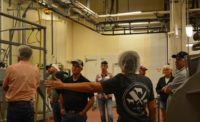Five governors and lieutenant governors visited Beef Products Inc. Thursday to tour its facility and see how lean finely textured beef is made.
Governor Terry Brandstad, Iowa, Governor Rick Perry, Texas, Governor Sam Brownback, Kansas, Lt. Governor Rick Sheehy, Nebraska, and Lt. Governor Matt Michels, South Dakota, participated in the tour along with U.S. Under Secretary of Food Safety Dr. Elisabeth Hagen, several of the states' Secretaries of Agriculture, a meat scientist, and reporters from print and broadcast news organizations.
"We were honored to host the governors and lieutenant governors and are grateful to them for taking the time to see for themselves what we make: high quality lean beef with an exceptional safety record," said Eldon Roth, founder of the family-owned business that started in 1981.
Sensationalized media reports have dubbed BPI's lean beef trim 'pink slime,"
"Pink slime completely mischaracterizes the beef Eldon and his company make. Reporters need to stop using the term and scaring people unnecessarily. I have been through this facility many times, and I can tell you this product is 100% beef and is produced in a way that is safe," said Gary Acuff, Ph.D., and director of the Center for Food Safety at Texas A&M University in College Station, Texas.
Nancy Donley, founder of STOP Foodborne Illness, met Eldon Roth after she made it her life cause to improve the safety of the food supply. Donley's six-year-old son, Alex, became ill and died from E. coli O157:H7 in a hamburger he had eaten.
"I just can't imagine why anyone would vilify what Eldon and his family have done. They have made beef safer," said Donley. "The Governors and journalists saw today what I have seen in my previous visits to the facility: BPI has a high level of commitment to safety. A product that is 100 percent beef is being unfairly maligned. I do hope people learn about the process themselves and reconsider their concern because it would be a tremendous disservice to the safety of our food supply to take the intervention used to produce BPI's lean beef off the market."
When beef is processed, there are several safety interventions that are used from exposure to antibacterial agents to freezing to what safety experts call 'test-and-hold' procedures, which is when a sample of the final product is tested and the lot is only released after test results come back negative. The same is true for lean finely textured beef produced by BPI and others.
"We're working with a raw product. Any time you do that – whether it's lettuce, spices, chicken, beef or any other fresh food – the food passes several safety interventions to make sure it is as safe as it possibly can be when it arrives at our homes," said Acuff. "Much attention has been given to BPI's process of exposing the meat briefly to an ammonia gas, which has been FDA-approved for use in food safety systems since 1974. As someone who directs a leading food safety center, I can tell you ammonia is used in many food systems. And that makes good sense. Ammonia is naturally found in many foods, including beef, chocolate, cheese and baked goods, and it very effective in ensuring safety," said Acuff.
Craig Letch, director of food safety and quality assurance for BPI, led the visitors on the tour. Before going into the plant, he described the computerized control systems that monitor each piece of equipment in the facility and he showed the delegation the fresh beef trim that is used to make lean beef trim as well as the 94 to 97 percent fresh ground beef product the plant makes before it is frozen and shipped. They then went into the plant and saw the product being made.
Source: Beef Products Inc.



Report Abusive Comment